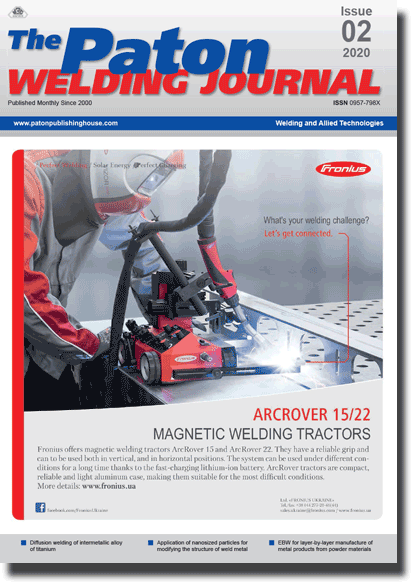| 2020 №02 (04) |
DOI of Article 10.37434/tpwj2020.02.05 |
2020 №02 (06) |

The Paton Welding Journal, 2020, #2, 26-29 pages
Corrosion resistance of composite material deposited by tig method using flexible cord TeroCote 7888T
B.V. Stefaniv, L.I. Nyrkova, A.V. Larionov and S.O. Osadchuk
E.O. Paton Electric Welding Institute of the NAS of Ukraine 11 Kazymyr Malevych Str., 03150, Kyiv, Ukraine. E-mail: office@paton.kiev.ua
Abstract
Increasing the corrosion resistance of drill bits with protective coatings is an urgent problem in Ukraine. For drilling tool, the main indices of physical and mechanical properties of wear-resistant coatings are abrasive wear, corrosion resistance and hardness (microhardness). It allows effectively resisting wear of working bodies of blades and a body of drill bits under the conditions of alternating and shock loads, hydroabrasive wear, corrosion, erosion, etc. It was investigated that a uniform distribution of tungsten carbide particles throughout the whole volume of deposited layer causes the same hardness over the coating depth and significantly increases the resistance of coating to corrosion wear. It is shown that microhardness of the matrix of a composite material TeroCote 7888T based on NiCrBSi exceeds the microhardness of steel 30Kh by 2.2 times. According to the results of corrosion tests, it was established that the protection of steel 30Kh by a deposited layer on the basis of a composite material TeroCote 7888T under the conditions simulating operating ones allows reducing the corrosion rate of working bodies of steel drill bit by almost 53 times. 10 Ref., 1 Table, 4 Figures.
Keywords: surfacing, tungsten carbides, microstructure, microhardness, wear resistance, corrosion rate, corrosion spot
Received 05.11.2019
References
1. Wear-resistant materials. https://docplayer.ru/32381351-Iznosostoykie-materialy-i-tvyordye-splavy-na-osnove-kobalta.html [in Russian].2. Samsonov, G.V., Vitryanyuk, V.N., Chaplygin, F.I. (1974) Carbides of tungsten. Kiev, Naukova Dumka [in Russian].
3. Pierson, H.O. (1996) Handbook of refractory carbides and nitrides. New Jersey, Noyes Publ. https://doi.org/10.1016/B978-081551392-6.50001-5
4. Stefaniv, B.V. (2016) Investigation of wear resistance of protective coatings under conditions of hydroabrasive wear. The Paton Welding J., 9, 26-29. https://doi.org/10.15407/tpwj2016.09.05
5. GOST 2999-75: Vickers hardness test [in Ukrainian].
6. GOST 9.908-85 (USCAP: Metals and alloys. Methods for determination of corrosion and corrosion resistance indices [in Russian].
7. Wear-resistant materials. http:// www.svarka 52.ru/upload/osnovnoj_katalog_po_paike_i_Terocote_BRAZING_1.pdf [in Russian].
8. GOST 9.907-83 (USCAP): Metals, alloys, metallic coatings. Methods for removal of corrosion products after corrosion tests [in Russian].
9. GOST 9.311-87 (USCAP): Metal and non-metal inorganic coatings. Method of corrosion damage evaluation [in Russian].
10. GOST 9.502-82 (USCAP): Inhibitors of metals corrosion for aqueous systems. Methods of corrosion tests [in Russian].
Suggested Citation
B.V. Stefaniv, L.I. Nyrkova, A.V. Larionov and S.O. Osadchuk (2020) Corrosion resistance of composite material deposited by tig method using flexible cord TeroCote 7888T. The Paton Welding J., 02, 26-29.The cost of subscription/purchase order journals or individual articles
| Journal/Currency | Annual Set | 1 issue printed |
1 issue |
one article |
| TPWJ/USD | 384 $ | 32 $ | 26 $ | 13 $ |
| TPWJ/EUR | 348 € | 29 € | 24 € | 12 € |
| TPWJ/UAH | 7200 UAH | 600 UAH | 600 UAH | 280 UAH |
| AS/UAH | 1800 UAH | 300 UAH | 300 UAH | 150 UAH |
| AS/USD | 192 $ | 32 $ | 26 $ | 13 $ |
| AS/EUR | 180 € | 30 € | 25 € | 12 € |
| SEM/UAH | 1200 UAH | 300 UAH | 300 UAH | 150 UAH |
| SEM/USD | 128 $ | 32 $ | 26 $ | 13 $ |
| SEM/EUR | 120 € | 30 € | 25 € | 12 € |
| TDNK/UAH | 1200 UAH | 300 UAH | 300 UAH | 150 UAH |
| TDNK/USD | 128 $ | 32 $ | 26 $ | 13 $ |
| TDNK/EUR | 120 € | 30 € | 25 € | 15 € |
AS = «Automatic Welding» - 6 issues per year;
TPWJ = «PATON WELDING JOURNAL» - 12 issues per year;
SEM = «Electrometallurgy Today» - 4 issues per year;
TDNK = «Technical Diagnostics and Non-Destructive Testing» - 4 issues per year.


